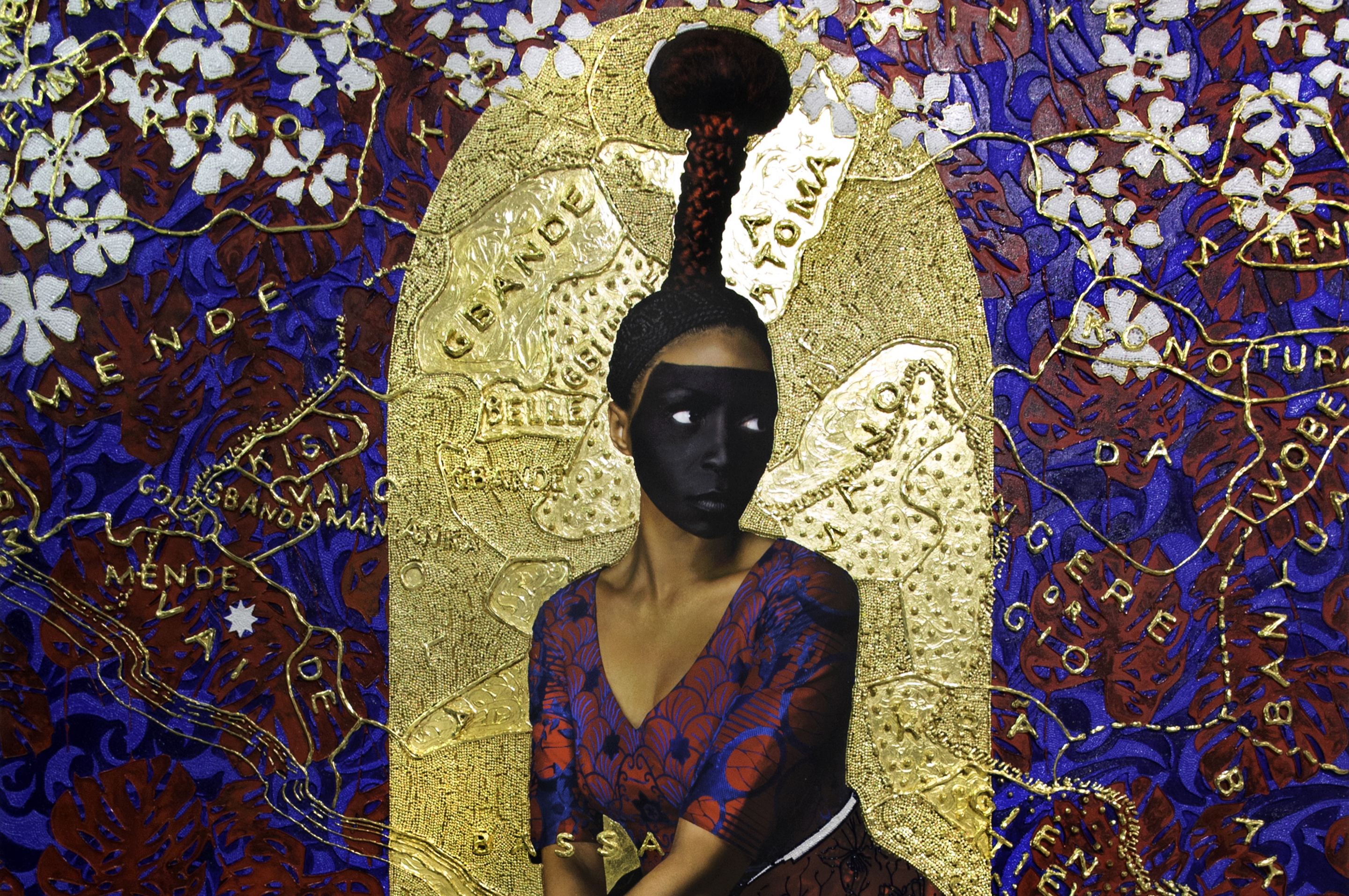For just a few more days, in the Great Hall of the New Orleans Museum of Art (NOMA), Lina Iris Viktor‘s “A Haven. A Hell. A Dream Deferred.” is on view. The exhibition of new paintings explores America’s involvement in the founding of Liberia in the early 19th century. Through a series of gilded portraits, Viktor weaves a tale around the trans-Atlantic slave trade, colonization, and ultimately a paradise lost. Incorporating symbolism from West Africa and America, she tells the forgotten story that links Liberia with the antebellum United States.
The New York- and London-based artist is well-known for her “Constellation” series in black, white, and gold mixing portraiture, pattern, and iconography. Whitewall spoke with Viktor about the new body of work, and what she’s working towards in 2019.
WHITEWALL: What was the starting point for “A Haven. A Hell. A Dream Deferred.”?
LINA IRIS VIKTOR: I started this work in January of 2017. The inspiration is what I call the lost narrative around the founding of Liberia and America’s involvement in that—of which people are very unaware. NOMA approached me to do a show in their Great Hall during the New Orleans tricentennial. So, I did research about the Antebellum South and found a lot of cross-pollination, which worked out very well.
WW: When you install your work, you typically like to create an immersive environment. How were you able do that in NOMA’s Great Hall?
LIV: I create spaces all the time that mirror or work in context with the pieces. There’s so much architectural importance and gravitas in that space, that it works in perfect tandem. I was thinking about as well the two-floor aspect—the fact that my works are on the bottom floor and there is the permanent collection of European paintings above. There’s an aesthetic conversation that happens.
WW: Were there any new materials or techniques you explored with this body of work?
LIV: The gilding is still there but the portrait work is more immersive than in “Constellations.” I build up these canvases. I make them very dense and very sculptural. The difference is that these works are on paper—save for one.
It was interesting because there’s a fragility to paper. Having these heavy applications does feel more fragile than working on canvas. I also started working more with inks and wash and different kinds of paint.
WW: How are you drawn to color and how does it come into a body of work?
LIV: I think my practice has always had restrictions, which I find allows for great exploration, rather than having all things at your disposal. Colors I’ve chosen up until now—apart from gold, which is more metal than color—are from an art historical kind of template. They’re important in art history, but also in culture. The deep lapis blue, which goes way back to the ancient Egyptians, the Mayans… there’s almost a vibration or frequency that it causes. It’s a very evocative color and a transcendent color. The decision to use that color was very intuitive, but since I’ve done my due diligence and discovered the historical context to it, the spiritual context to it, and my own relationship to it.
With this body of work, there’s the addition of red. I’m making a reference to the iconography and the emblematic aesthetic that was taken from Great Britain to America, and America to Liberia. Liberia adopted many of America’s iconography—the flag is pretty much the same except it has one star; the coinage; the stamps. The hues I’m using are very deep red, like crimson. It’s very evocative and leading.
It creates a destabilization because they’re not colored to be realistic, they’re colored to create a visceral reaction.
WW: Your work has a kind of visual language. How did you start working within that?
LIV: I’ve only had my practice about five years now. It happened pretty immediately. I knew what I wanted to say and I knew how I wanted to express it. I understood the inherent value of symbol, I understood the more subliminal level in imagery that is infused in global consciousness. Every culture has symbols that predate modern language.
That’s been my driving force, to show a heavy symbolism that already existed. I’m not trying to reinvent the wheel. I know this is very steeped in a long tradition globally. By pulling from all kinds of different cultural and historical contexts, and creating an amalgamation, I’m making it my own. The intent is that it will elicit a subconscious reaction.
WW: After your show at NOMA, what will your winter and spring look like for 2019?
LIV: I’m trying to pace my time more because the works are very production heavy. I’m focusing more on exhibitions. I will have a show in 2019 during Frieze London at Autograph ABP and before that, I’m sure things will come up. But right now, I’m just trying to work on milestones—solo exhibitions, that’s the next milestone.
“A Haven. A Hell. A Dream Deferred” is on view through January 6, 2019.










